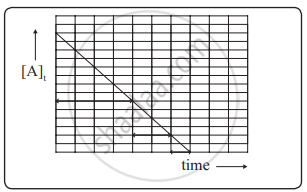Advertisements
Advertisements
प्रश्न
Answer the following in brief.
How will you represent the zeroth-order reaction graphically?
उत्तर
Graphical representation of zero-order reactions: The rate law is given as

which is a straight line given by y = mx + c.
A plot of `["A"]_"t"` versus t is a straight line.

[A]t vs t for zero-order reaction
The slope of the straight line is -k and its intercept on the y-axis is `["A"]_0`.
APPEARS IN
संबंधित प्रश्न
Answer the following in one or two sentences.
What are the units for rate constants for zero-order and second-order reactions if time is expressed in seconds and concentration of reactants in mol/L?
How will you represent first order reactions graphically.
Solve
The half-life of a first-order reaction is 1.7 hours. How long will it take for 20% of the reactant to react?
Answer the following in brief.
Give one example and explain why it is pseudo-first-order.
Derive an integrated rate law expression for first order reaction: A → B + C
Define half life of a reaction.
Write units of rate constants for:
- First-order reaction
- Zero-order reaction
A zero-order reaction \[\ce{X -> Product}\], with an initial concentration 0.02 M has a half-life of 10 min. if one starts with concentration 0.04 M, then the half-life is
For a first order reaction \[\ce{A ->Product}\] with initial concentration x mol L−1, has a half life period of 2.5 hours. For the same reaction with initial concentration `("x"/2)` mol L−1 the half life is
Assertion: rate of reaction doubles when the concentration of the reactant is doubles if it is a first-order reaction.
Reason: rate constant also doubles.
The rate constant of a reaction is 5.8 × 10−2 s−1. The order of the reaction is ____________.
A zero order reaction is 20% complete in 20 minutes. Calculate the value of the rate constant. In what time will the reaction be 80% complete?
From the following data, show that the decomposition of hydrogen peroxide is a reaction of the first order:
| t (min) | 0 | 10 | 20 |
| V (ml) | 46.1 | 29.8 | 19.3 |
Where t is the time in minutes and V is the volume of standard KMnO4 solution required for titrating the same volume of the reaction mixture.
A first order reaction has a rate constant 0.00813 min-1. How long will it take for 60% completion?
For first order reaction the concentration of reactant decreases from 0.2 to 0.1 M in 100 minutes. What is the rate constant of the reaction?
The time of completion of 90% of a first order reaction is approximately ____________.
For the first order reaction, plot of log10 [A]t against time 't' is a straight line with a negative slope equal to ____________.
Half-life period of a first order reaction, \[\ce{A -> product}\] is 3.0 hours. What is the value of rate constant?
The slope of a graph, log [A]t versus 't' for a first order reaction is −2.5 × 10−3 s−1. The rate constant for the reaction is ____________.
For a zero order reaction, the plot of [A]t vs t is linear. The slope of the line is equal to ____________.
The half-life of a first order reaction is 6.0 hour. How long will it take for the concentration of reactant to decrease from 0.4 M to 0.12 M?
Which among the following is an example of zero order reaction?
A first order reaction is 50% completed in 16 minutes. The percentage of reactant that will react in 32 minutes is ____________.
For the first order reaction A → B, the rate constant is 0.25 s-1, if the concentration of A is reduced to half, the value of rate constant will be ________.
The rate constant and half-life of a first order reaction are related to each other as ______.
Which of the following reactions is not of the first order?
The rate constant for a first order reaction is 7.0 × 10-4 s-1. If initial concentration of reactant is 0.080 M, what is the half-life of reaction?
The half-life of first order reaction is 1.7 hour. What is its rate constant?
The half-life period for the first order reaction is 1.7 hrs. How long will it take for 20% of the reactant to disappear?
